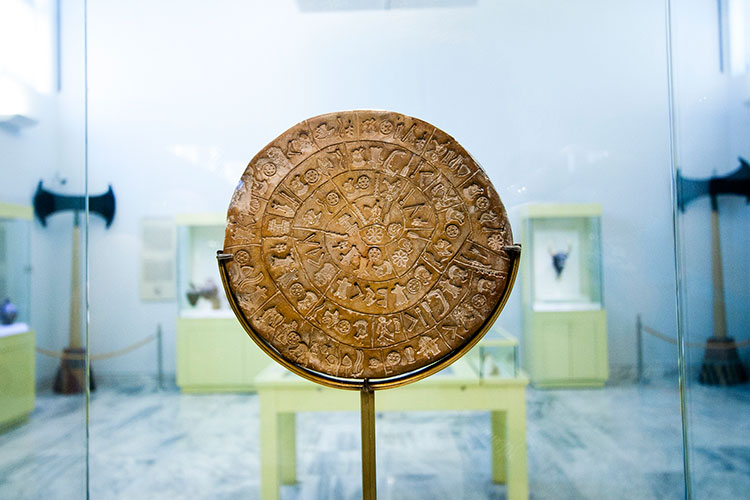
Heraklion Archaeological Museum
The Heraklion Archaeological Museum is regarded as one of Europe''s most important museums. The present building was constructed between 1933 and 1937 to plans by P. Karantinos, on the site of the imposing Venetian Franciscan friary destroyed by an earthquake in 1856.
The museum brings together archaeological finds from all over Crete, covering over 5500 years of the island''s history. Pride of place is given to the treasures of Minoan civilisation, the entire historical course of which can thus be appreciated. Justly regarded as the home of Minoan civilisation par excellence, the museum houses the most important collection of Minoan antiquities the world over.
The museum brings together archaeological finds from all over Crete, covering over 5500 years of the island''s history. Pride of place is given to the treasures of Minoan civilisation, the entire historical course of which can thus be appreciated. Justly regarded as the home of Minoan civilisation par excellence, the museum houses the most important collection of Minoan antiquities the world over.
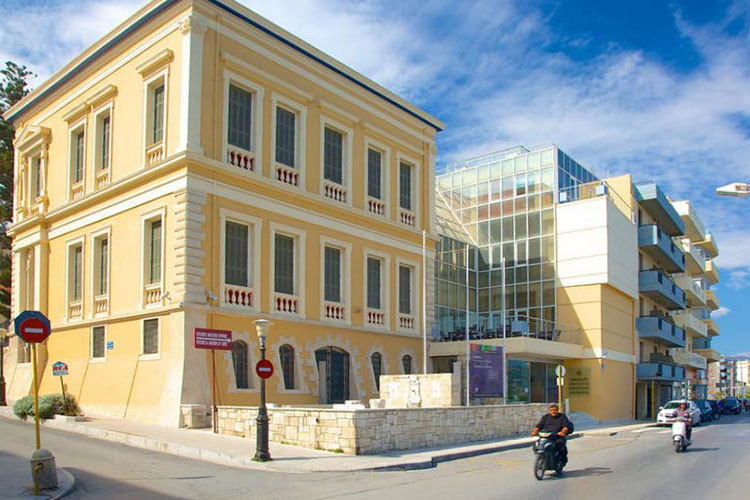
Historical Museum of Crete
Founded in 1953 by the Society of Cretan Historical Studies, the Historical Museum of Crete presents a comprehensive view of Cretan history from early Christian times to the present day. The original goal of those founding the Historical Museum of Crete was to collect and preserve valuable archaeological, ethnographic and historical material deriving from the medieval and modern periods in Cretan history.
The H.M.C. is home to the following collections: Medieval and Renaissance Collection, Struggles for Cretan Freedom, Folklore Collection, Nikos Kazantzakis Room, Emmanouil Tsouderos Room
Permanent Exhibitions: G. Kalokerinos Room, Introduction to the Christian Era on Crete, Tour of 17th century Chandax (Heraklion), Ceramics Room
The H.M.C. is home to the following collections: Medieval and Renaissance Collection, Struggles for Cretan Freedom, Folklore Collection, Nikos Kazantzakis Room, Emmanouil Tsouderos Room
Permanent Exhibitions: G. Kalokerinos Room, Introduction to the Christian Era on Crete, Tour of 17th century Chandax (Heraklion), Ceramics Room
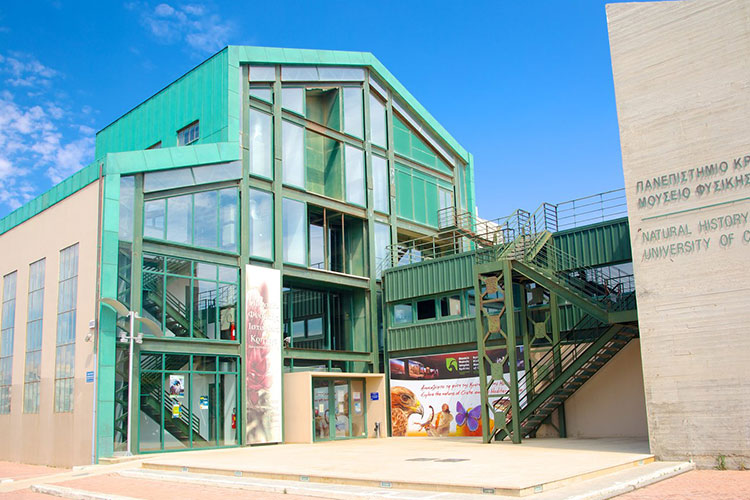
Natural History Museum of Crete
Operating within the wider University of Crete framework, the Natural History Museum of Crete fulfils all the roles demanded of a comprehensive, modern museum by:
- Keeping and developing collections
- Carrying out research into the natural world
- Contributing to teaching at all levels in the education system
- Promoting the unique nature of habitats in Crete and the Mediterranean.
The museum''s impressive growth over the last decade reflects the competence and professionalism of its staff, as well as the growing need in society for proper information concerning the environment.
- Keeping and developing collections
- Carrying out research into the natural world
- Contributing to teaching at all levels in the education system
- Promoting the unique nature of habitats in Crete and the Mediterranean.
The museum''s impressive growth over the last decade reflects the competence and professionalism of its staff, as well as the growing need in society for proper information concerning the environment.
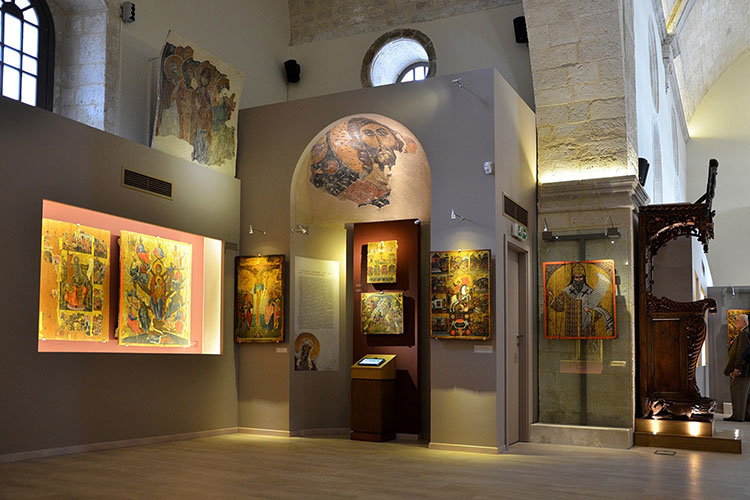
Saint Catherine's Museum
Situated northeast of the Cathedral of St. Minas, this church once belonged to the Monastery of St. Catherine on Mt. Sinai. The church was founded in the second Byzantine period, and was a centre of intellectual and artistic activity from the 15th to the 17th century.
St. Catherine's now serves as an exhibition venue owned by the Archdiocese of Crete. It houses works representative of the Cretan Renaissance, the most outstanding of which are portable icons by Michail Damaskinos. The displays also include collections of altar furnishings, books, vestments and detached murals.
St. Catherine's now serves as an exhibition venue owned by the Archdiocese of Crete. It houses works representative of the Cretan Renaissance, the most outstanding of which are portable icons by Michail Damaskinos. The displays also include collections of altar furnishings, books, vestments and detached murals.
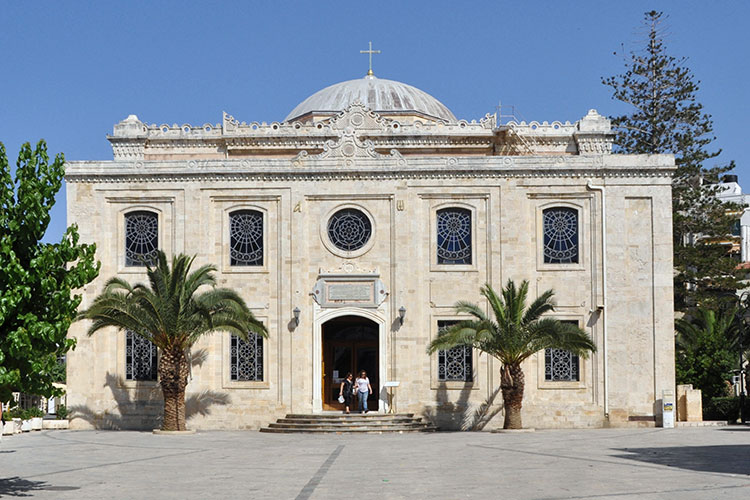
Saint Titos
With the recovery of Crete from Nikiforos Fokas, the seat of the bishopric is transferred from Gortyna to Chandakas, which became the capital of the island. The new cathedral, which is the most established and largest in the city, is dedicated to the Apostle Titos. Here, amongst other relics, there are gathered the Holy Skull of the Apostle and the miraculous icon of Messopapaditissas. When the Venetians took over Crete, they installed in the orthodox bishop the Latin archbishop, converting by that the church of St. Titos into a Latin bishop.
In the middle of the 15th century, the Latin archbishop, F. Dandolo is renovating the church. Other distractions, caused by earthquakes and fire, resulted to the rebuilding of the church from the start around 1557. The church was a basilica, almost square in shape, with a dome in the middle and a bell-tower in the southwest corner. The church from the inside was divided in three aisles with two series of columns. During the Turkish period, the church was given to Fazil Ahmet Kioprouli and it was changed into a mosque, while the bell - tower was tranformed into a minaret. The big earthquake of 1856 destroyed the temple which is being, once more, rebuilt. After the exchange of populations, the Church of Crete repaired it accordingly, and in 1925 it was dedicated again to Apostle Titos.
In the middle of the 15th century, the Latin archbishop, F. Dandolo is renovating the church. Other distractions, caused by earthquakes and fire, resulted to the rebuilding of the church from the start around 1557. The church was a basilica, almost square in shape, with a dome in the middle and a bell-tower in the southwest corner. The church from the inside was divided in three aisles with two series of columns. During the Turkish period, the church was given to Fazil Ahmet Kioprouli and it was changed into a mosque, while the bell - tower was tranformed into a minaret. The big earthquake of 1856 destroyed the temple which is being, once more, rebuilt. After the exchange of populations, the Church of Crete repaired it accordingly, and in 1925 it was dedicated again to Apostle Titos.
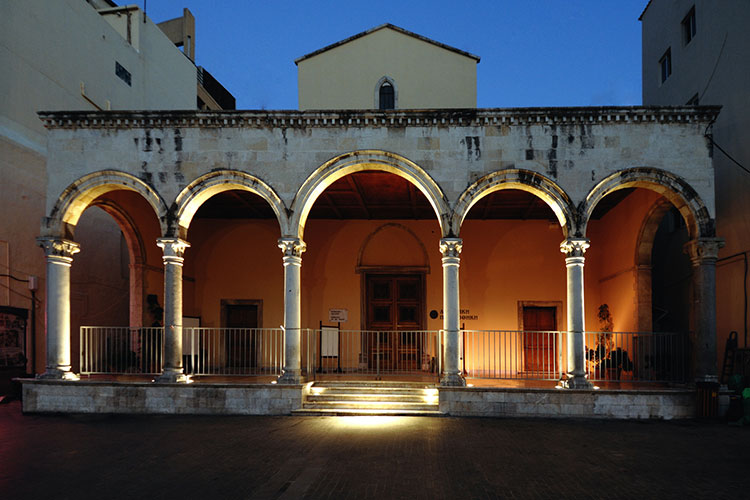
Basilica of Saint Mark
One of the first and quite important works of the Venetian settlers was the building of a temple dedicated to their patron, St. Mark, in the centre of the city and opposite to the Palace of the Duke. Within the church all the lords and the state officials used to assume their duties with every formality while common people used to seek protection from their patron Saint. When the Turks took over the city - Kastro -, the church of St. Mark was given to Defterdar Ahmet Passa who converted it into a mosque, named after him. The bell tower was demolished and in its place they built a minaret. The new conquerors, without having any respect for the sacred place, destroyed the frescoes and the Christian graves. After the exchange of population and the Turkish withdrawal, St. Marc came to the jurisdiction of the National Bank and then of the Municipality. Lastly, in 1956 a contract was signed between the Municipality and the E.K.I.M (Society of Cretan Historical Studies) in order to start the restoration of the building, so today it is an ornament for the city that is used as Municipal Art Gallery.
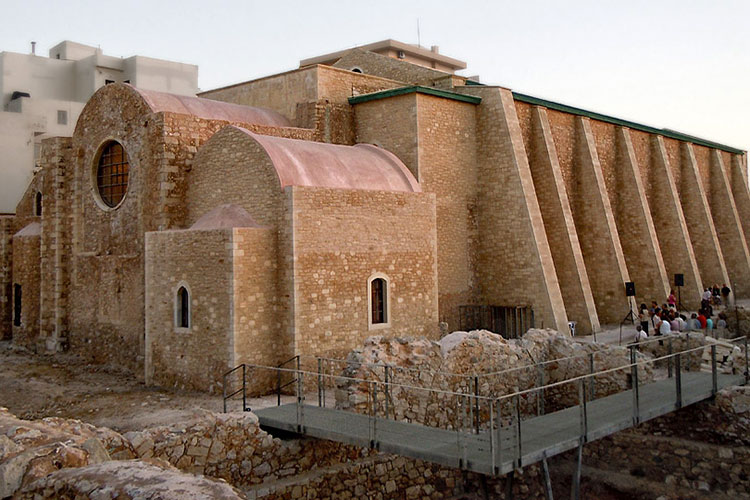
Monastery of St. Peter and St. Paul
It is situated approximately in the middle of the seaside wall. It was built from the first years of the venetian domination and belonged to the monastic order of Dominicans (Domenicani Predicatori). It was one of the most important and biggest Catholic monasteries of the city. The earthquake of 1508 caused a lot of damages to the temple.
During excavations that took place recently in the wider area of the temple (area of Kastella) graves of the second Byzantine period came to light and underneath them an extended habitation of the Arabic period that gave a lot of information for the architecture and the style of life of that era. The finds from this excavation are exhibited in the Historical Museum.
The monastery, partly destroyed during the Turkish occupation, was made into a mosque of Sultan Ibrahim with a minaret at its southwest corner. Today it is reconstructed under the supervision of the 13th Archaeological Service and the Cretan Archdiocese. After the reconstruction, the holy place will be used as a festive temple and a meeting place for international, orthodox, Christian and religious congresses.
During excavations that took place recently in the wider area of the temple (area of Kastella) graves of the second Byzantine period came to light and underneath them an extended habitation of the Arabic period that gave a lot of information for the architecture and the style of life of that era. The finds from this excavation are exhibited in the Historical Museum.
The monastery, partly destroyed during the Turkish occupation, was made into a mosque of Sultan Ibrahim with a minaret at its southwest corner. Today it is reconstructed under the supervision of the 13th Archaeological Service and the Cretan Archdiocese. After the reconstruction, the holy place will be used as a festive temple and a meeting place for international, orthodox, Christian and religious congresses.
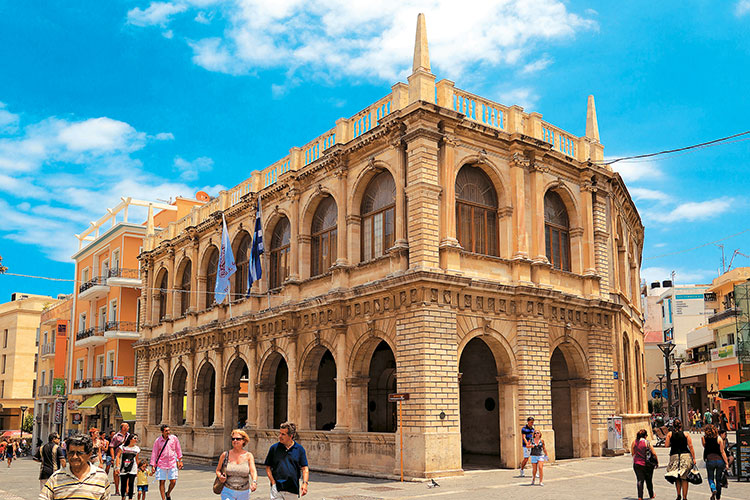
Loggia
It is an essential public building in every Venetian city, which was not absent even from the colonies. For Candia, Loggia is considered to be one of the most elegant architectural monuments of the Venetian period, a representative sample of the palladian style. During the Venetian period, Loggia was the official meeting place of sovereigns and nobility where they discussed various topics that had to do with economic matters, commercial, and political ones. It was also used as a place where people passed their time, something like a combination of a Chamber and a Club. Today’s Loggia is the fourth one, the others, that were built before that, were abandoned due to their position, or were destroyed by the time. The last Loggia was built at about 1628 by the "General Provisioner" Frangisko Morozini, known also by the homonymous fountain in the centre of the town.
Later in 1904 (After, though an earthquake that happened) it was regarded that the building was ready to fall and people started, unfortunately without any care, to demolish the first floor. The year after the building was granted to the Town Hall in order to house some of its services. Ten years will go by until the first stone will be put officially for the restoration of Loggia. Still though, the works were delayed.
After some years and the end of the 2nd World War the works for the restoration of Loggia started afresh. The crowning of all these efforts was the awarding of the prize in 1987 from the International Organization "Europa Nostra" for the most successful restoration of a historical building with a modern use in the Greek area.
Later in 1904 (After, though an earthquake that happened) it was regarded that the building was ready to fall and people started, unfortunately without any care, to demolish the first floor. The year after the building was granted to the Town Hall in order to house some of its services. Ten years will go by until the first stone will be put officially for the restoration of Loggia. Still though, the works were delayed.
After some years and the end of the 2nd World War the works for the restoration of Loggia started afresh. The crowning of all these efforts was the awarding of the prize in 1987 from the International Organization "Europa Nostra" for the most successful restoration of a historical building with a modern use in the Greek area.
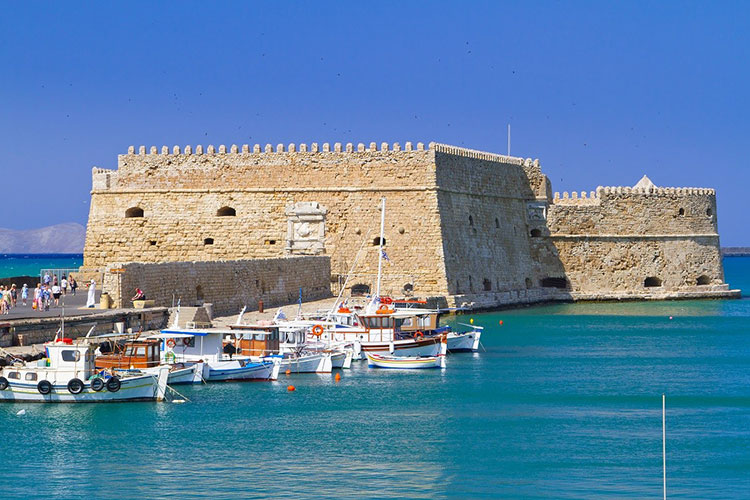
Koules Fortress
A Venetian seaside fortress situated at the entrance of the old harbor. It was built by the Venetians, before the construction of the new Venetian fortification, in order to protect the pier and the port. It took its last shape in the years between 1523 - 1540 replacing another construction destroyed by an earthquake. It has been continuously repaired due to the violent waves of the sea that always used to cause damages to its stonework and foundation.
It was built with big blocks of stone and it consisted of two floors. On the ground floor there exist 26 rooms that were used to house captains or to store food and ammunition. On the upper floor there are battlements for placing canons. The upper parts of the castle and the existing base of the minaret are Turkish changes. On the outside of the main sides of the castle, there are relief plaques that stand out with the lion of St. Mark, the symbol of Venice. During the Turkish period in the dark and humid rooms of the castle, the Turks used to torture and imprison the Cretan revolutionaries. Today, the castle is open to visitors and during the summer period it is used for various cultural activities (art exhibitions, music, theatre).
It was built with big blocks of stone and it consisted of two floors. On the ground floor there exist 26 rooms that were used to house captains or to store food and ammunition. On the upper floor there are battlements for placing canons. The upper parts of the castle and the existing base of the minaret are Turkish changes. On the outside of the main sides of the castle, there are relief plaques that stand out with the lion of St. Mark, the symbol of Venice. During the Turkish period in the dark and humid rooms of the castle, the Turks used to torture and imprison the Cretan revolutionaries. Today, the castle is open to visitors and during the summer period it is used for various cultural activities (art exhibitions, music, theatre).
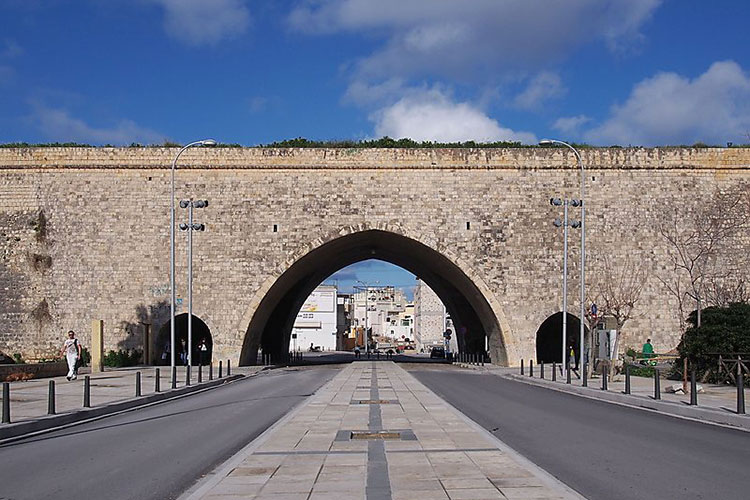
The City Walls
Heraklion is surrounded by a formidable medieval wall, which was used to protect it from enemies. Owing to this, the city enjoyed the reputation as a well-fortified state in the Mediterranean basin. It stood up to a siege from the Turks for 21 years, but was finally seized in 1669 after its betrayal by a Greek-Venetian engineer who informed the invaders of the walls' weaknesses at east and west bastions. It is possible now to walk along the top of these walls and enjoy a view over the city. You may reach the Grave of the Cretan writer Nikos Kazantzakis (1883-1957), where it is written: "I hope for nothing, I fear nothing; I am free".
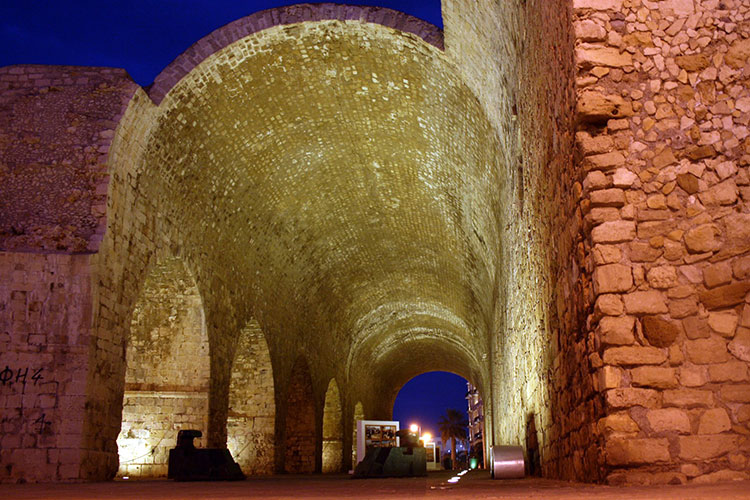
Venetian Harbor - Arsenals
Heraklion is surrounded by a formidable medieval wall, which was used to protect it from enemies. Owing to this, the city enjoyed the reputation as a well-fortified state in the Mediterranean basin. It stood up to a siege from the Turks for 21 years, but was finally seized in 1669 after its betrayal by a Greek-Venetian engineer who informed the invaders of the walls' weaknesses at east and west bastions. It is possible now to walk along the top of these walls and enjoy a view over the city. You may reach the Grave of the Cretan writer Nikos Kazantzakis (1883-1957), where it is written: "I hope for nothing, I fear nothing; I am free".
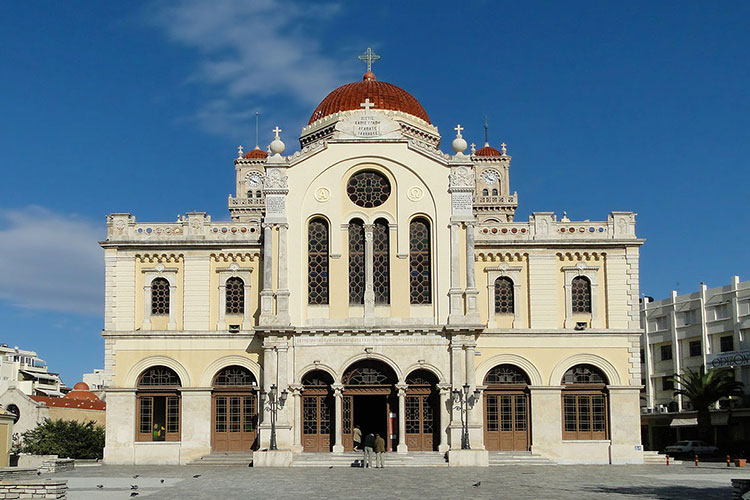
Agios Minas Cathedral
The Agios Minas Cathedral is a Greek Orthodox Cathedral in Heraklion, Greece, serving as the seat of the Archbishop of Crete. Saint Minas (Agios Minas in Greek) is the patron saint of Heraklion and his feast-day, on 11 November, is a public holiday.
In front of the Cathedral of Saint Minas is a large paved square. To the right is the Archiepiscopate of Crete; while to the left is the original little church of Saint Minas. The original church of Saint Minas, little Saint Minas as the local call it, was built in 1735 and housed the Metropolis of Crete for the first time after the Turkish occupation.
It was built over the time period of 1862-1895. The construction was interrupted during the Cretan Revolution of 1866–1869. It is one of the largest cathedrals in Greece, with a capacity of 8,000 people.
In front of the Cathedral of Saint Minas is a large paved square. To the right is the Archiepiscopate of Crete; while to the left is the original little church of Saint Minas. The original church of Saint Minas, little Saint Minas as the local call it, was built in 1735 and housed the Metropolis of Crete for the first time after the Turkish occupation.
It was built over the time period of 1862-1895. The construction was interrupted during the Cretan Revolution of 1866–1869. It is one of the largest cathedrals in Greece, with a capacity of 8,000 people.
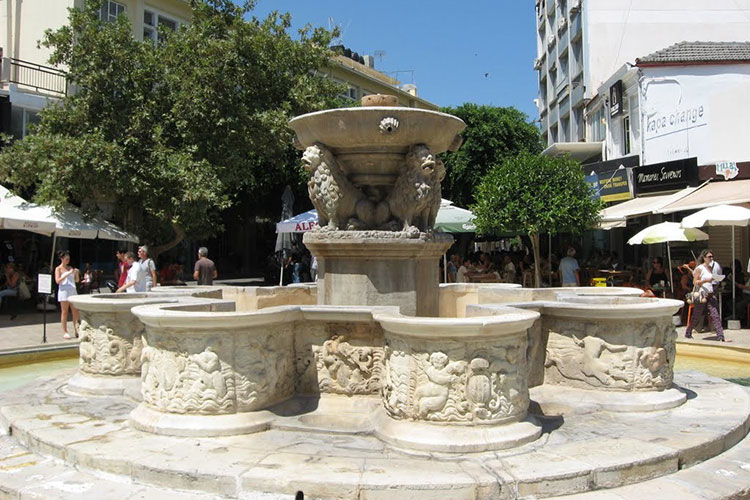
Morosini Fountain
Situated by 25th of August Street just across the Basilica of St. Marco, the imposing fountain of Morosini (popularly known as the “Lions”) is the ‘belly-button’ of the city and common meeting place for locals and visitors. The fountain was commissioned in 1628 by Francesco Morosini, the Venetian Governor of Crete, to deal with the water shortage of the city. Through a complex network of pipes, the mouths of the four lions gushed water transferred from the mountain of Yuchtas. Apart from the lions (symbol of Venice) the fountain is adorned by mythological representations and sea creatures (such as dolphins). Initially there was a statue of god Poseidon in the center of the fountain which is now missing. The most dominant theory says it was probably destroyed by an earthquake.
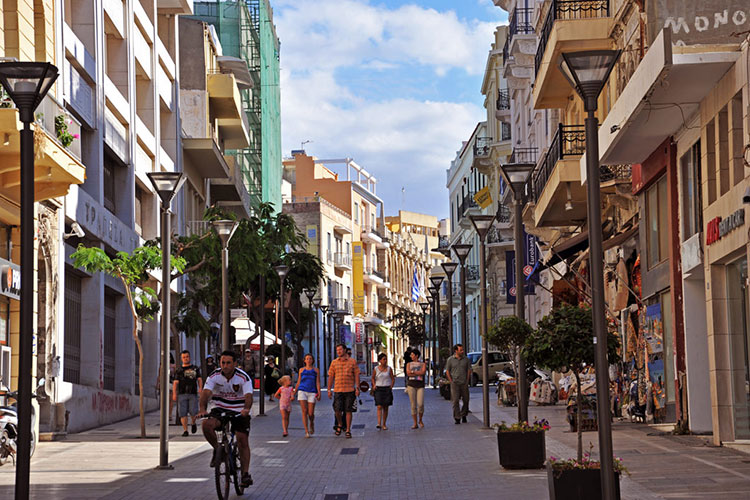
25th August Street
The car free 25 August St. is directly opposite the Old Harbor and extends to Lion Square. It takes its name from a massacre of ‘martyrs' which occurred in 1898. This involved the killing of many Cretans and, crucially, British in this area, by the Turks, finally forcing the ‘Great Powers' (Britain, France and Russia) to recognize Crete's struggle. These events led eventually to the declaration of a Cretan State and, finally, unification with Greece in 1913. Old and modern buildings compete for space now on the street named to remember 25th August.
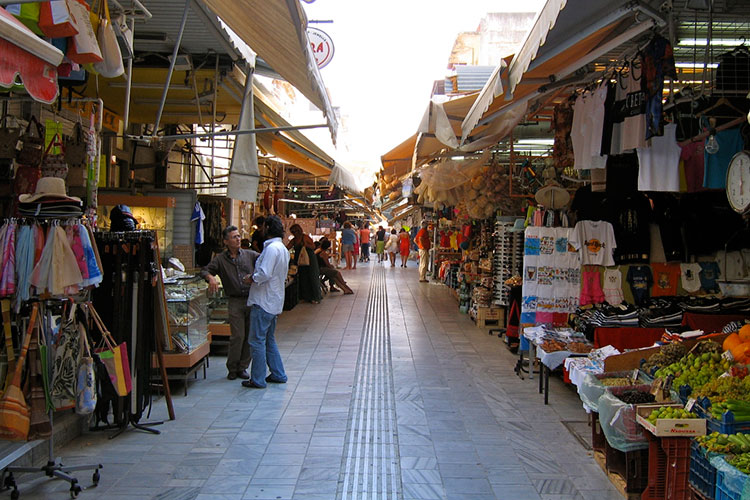
Market Street
Agora, the Market Street is located at a shopping boulevard called 1866. From top to bottom, with some shaded sideways exits, this old Market Street is still a place for ‘Herakliotes' to come every day to find socks, shirts, herbs, fish and fresh meat. It's a good place to find thyme honey, raki (the Cretan clear spirit) from among shops selling everything from selections of Cretan music to the finest cheese. This market has a long history, always a place to meet and make plans. Walk the side-streets and you will smell good Cretan food and feel the buzz around you.
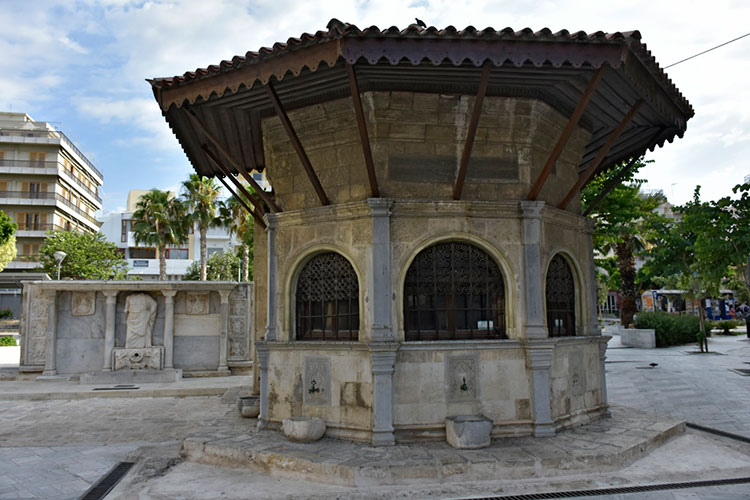
Plateia Kornarou
Plateia Kornarou lies at the top of the market, with a lovely Venetian fountain of its own, the Bembo Fountain, probably the oldest, and it bears some very good decoration, although it has ceased to fount. The Bembo Fountain was built in 1588 by Venetian architect Zuanne Bembo. It is decorated with columns, Venetian family coats-of-arms and a headless male statue, brought here from Ierapetra. At one time, people believed that the statue had supernatural powers and, every May, religious rituals were organised in its honour. The Plateia itself is named after Vitsenzos Kornaros (1553 to approx.1614), composer of the epic poem Erotokritos, which is regularly performed around Crete, and still evokes pride in every Cretan heart.
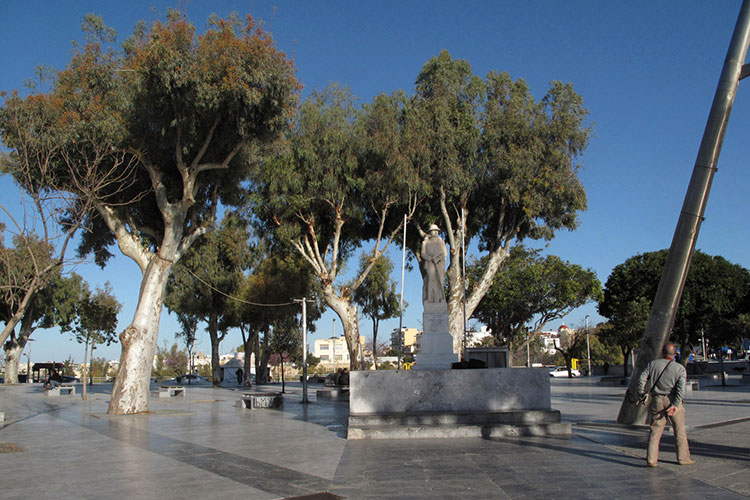
Plateia Eleftherias, οr Freedom Square
The spacious Plateia Eleftherias is worth exploring, built in a crescent shape alongside the Archaeological Museum and close to Heraklion's municipal buildings and the main foreign Consulates. Apart from breathing space, it offers the shaded park of Georgiades, a fine place to rest the feet and watch the busiest intersection in Heraklion. On the seaward side of the square is the entrance to St. George's Gate, used from Venetian times as a passage between the city and its port, the entrance is down stone steps, leading to an atmospheric dome-roofed chamber and the lower exit. The passage may still be accessed and is often the venue for art exhibitions. It is all that remains now of an important mediaeval entrance to the city. There are plenty of eating and drinking houses that occupy the north side of the square.